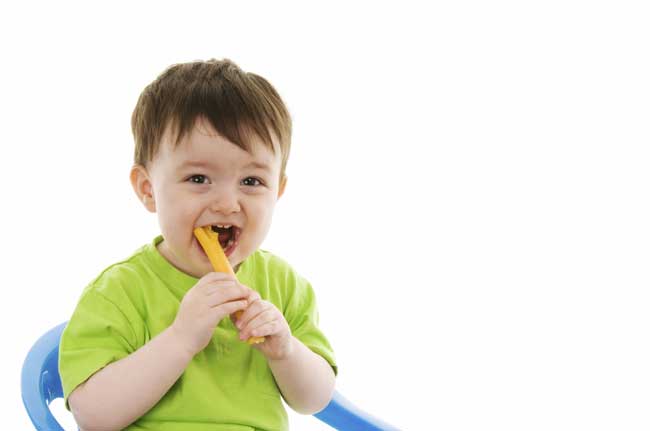 Warm welcome to guest blogger, Melanie Potock, MA, CCC-SLP. Melanie works with many autistic children with food allergies in her feeding therapy practice.
Warm welcome to guest blogger, Melanie Potock, MA, CCC-SLP. Melanie works with many autistic children with food allergies in her feeding therapy practice.
One in 88 Children
April is National Autism Awareness Month. “1 in 88 children has been identified with an autism spectrum disorder (ASD)” according to estimates from
CDC's Autism and Developmental Disabilities Monitoring (ADDM) Network, which goes on to report that “ASDs are almost 5 times more common among boys (1 in 54) than among girls (1 in 252).”
Startling statistics, but it corresponds perfectly with my therapy practice as a feeding specialist.
While my private practice is devoted to helping all children learn the joy of food, currently 25% of my caseload are precious boys who have autism spectrum disorder (ASD). I’ve come to know this group of children quite well and their unique challenges when it comes to trying new foods. (For the reader’s ease, please allow me to use the pronoun “him” in this article, while keeping in mind the wonderful girls who also have ASD.)
Central Features of ASD
What distinctive
characteristics of ASD hinder these kiddos from trying new foods? Let’s look very briefly at some of the central features of ASD, while keeping in mind that this a spectrum disorder, with symptoms ranging from mild to severe, this list does not encompass all of the elements of a diagnosis.
Some of the central features that kids with ASD have difficulty with are:
- Social interaction, often including social reciprocity or that back and forth communication exchange known as conversation
- Spoken language
- Restricted behaviors often marked by rigid behavior patterns or an inability to be flexible with change
- While not a criteria for diagnosis, kids with ASD commonly have sensory processing difficulties that hinder their ability to tolerate different tastes, temperature and/or textures of food and deal with change in general
The Hailstorm
In therapy, I assess and treat a child’s ability to allocate specific cognitive resources in the brain in order to manage day-to-day life.
EXAMPLE: here is a common event where, as an adult, you have to utilize many different parts of their brain.
You are driving the minivan full of kids to soccer practice, radio blaring, kids chattering. Your brain is operating relatively smoothly, filtering auditory, visual, tactile and other sensations, while remembering to use your turn signal, maintain the speed limit, etc. Suddenly, the weather changes and it starts to hail. What’s the first thing you do? Turn off the radio and tell the kids “Shush…Mommy needs to concentrate on the road.” Perhaps you even slow down so that you can focus on the sudden change in driving conditions. You have eliminated as much sensory input as possible so that you can concentrate on the task at hand – driving safely. Funny how you were driving perfectly fine until one thing changed in your environment.
Life is Sticking to Sameness. Therapy is Adapting to Change.
Consider the child with autism as he attempts to engage in mealtimes. The reality is that daily life changes as easily as the daily weather report and some days are just like driving through a hailstorm. This child is already challenged by poor sensory processing; he has limited ability to take in information through all of the senses, process it and filter out the unimportant info, and then act upon only the important information.
Now, bring that child to the family dinner table, which is all about social interaction and conversation. Put a plate of food in front of him which looks and smells completely different from the last meal he was served. Then, tell him to try that steamed broccoli for the very first time. He doesn’t get to turn down the sensory input bombarding him at the table and focus just on the broccoli. Because he has autism, he can’t filter out which stimuli might be inconsequential and it feels so much safer to follow rigid behavior patterns and never try anything new.
Life for a child with autism is all about sticking to sameness. Therapy for a child with autism is all about learning to deal with change.
Autism, Food Allergies & Learning
Contemplate the fact that many children with ASD have the additional challenge of
food allergies and/or intolerances, making choices limited when learning to try new foods. For the older child heading to school, therapy will include teaching a child about his allergies and which foods are safe, so that he can be
make safe choices independently ... while dealing with the ever-changing school environment, too.
In my
feeding therapy practice, the very first sessions are conducted in a child’s home. Learning about new foods begins away from a family mealtime, where I can control the amount of sensory input a child has to process in order to keep his body organized and stable for small changes, such as a new food presented as we sit at the kitchen counter. Once a child has learned to enjoy approximately 25 foods at home, the next step may be a restaurant or the school cafeteria.
Keep in mind that this is more than just a change in venue. Now, the visual input is different and it changes constantly, the inconsistent auditory input can be overwhelming, the fluctuating smells may be interpreted as noxious, etc. Every input to every sense has changed. Once again, he is encountering a hailstorm and has to learn to tune out the distractions and focus on the task at hand – in this case, eating a nutritious meal away from home.
Reach Out
Perhaps you are a parent of a child with ASD. Perhaps you have observed a child whom you suspect may be dealing with the daily trials of autism. Thank you for considering what mealtimes feel like for him and his family. It does get better, but it is a journey that requires patience from family, friends and the community.
Please share this article with a friend so that we can continue to raise awareness of Autism Spectrum Disorder and if you know someone who loves a child with ASD, do something special for them this month in honor of National Autism Awareness Month – thank you!
About Melanie
 Melanie Potock, MA, CCC-SLPMelanie is speech language pathologist who specializes in feeding. Her work brings her into the homes and schools of her clients, kids, who for various reasons have difficulty with food or with eating. She works with kids and their parents to develop effective strategies that help children become “more adventurous eaters”. At least 50% of her clients have food allergies or intolerances, and for them, “adventurous eating” takes on a special meaning. Melanie is also the author of Happy Mealtimes with Happy Kids” and the executive producer of “Dancing in the Kitchen.”
Melanie Potock, MA, CCC-SLPMelanie is speech language pathologist who specializes in feeding. Her work brings her into the homes and schools of her clients, kids, who for various reasons have difficulty with food or with eating. She works with kids and their parents to develop effective strategies that help children become “more adventurous eaters”. At least 50% of her clients have food allergies or intolerances, and for them, “adventurous eating” takes on a special meaning. Melanie is also the author of Happy Mealtimes with Happy Kids” and the executive producer of “Dancing in the Kitchen.”
More Posts from Melanie
Review: The Magic of the BellyFull Kit (From the Hopeful Company)
The 12 Days of Christmas -- My Favorite Lunchtime Things (Part 1)
Tips to Help Your Food Allergic Child Belong During the Holidays
How to Talk Turkey (and Food Allergies) at Thanksgiving
How Can Parents Feel Less Stress with a Food Allergic Child in School?
 Monday, April 9, 2012 at 1:35PM
Monday, April 9, 2012 at 1:35PM  Melanie Potock, MA, CCC-SLP tagged
Melanie Potock, MA, CCC-SLP tagged  autsim,
autsim,  behavioral treatment,
behavioral treatment,  feeding therapy,
feeding therapy,  food allergies
food allergies  Email Article
Email Article  Print Article in
Print Article in  Health,
Health,  Parents/Kids
Parents/Kids  Warm welcome to guest blogger, Melanie Potock, MA, CCC-SLP. Melanie works with many autistic children with food allergies in her feeding therapy practice.
Warm welcome to guest blogger, Melanie Potock, MA, CCC-SLP. Melanie works with many autistic children with food allergies in her feeding therapy practice. 
 Melanie Potock, MA, CCC-SLPMelanie is speech language pathologist who specializes in feeding. Her work brings her into the homes and schools of her clients, kids, who for various reasons have difficulty with food or with eating. She works with kids and their parents to develop effective strategies that help children become “more adventurous eaters”. At least 50% of her clients have food allergies or intolerances, and for them, “adventurous eating” takes on a special meaning. Melanie is also the author of Happy Mealtimes with Happy Kids” and the executive producer of “Dancing in the Kitchen.”
Melanie Potock, MA, CCC-SLPMelanie is speech language pathologist who specializes in feeding. Her work brings her into the homes and schools of her clients, kids, who for various reasons have difficulty with food or with eating. She works with kids and their parents to develop effective strategies that help children become “more adventurous eaters”. At least 50% of her clients have food allergies or intolerances, and for them, “adventurous eating” takes on a special meaning. Melanie is also the author of Happy Mealtimes with Happy Kids” and the executive producer of “Dancing in the Kitchen.”
